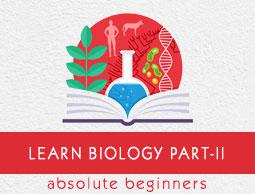| Branch |
Studies |
| Anatomy |
Study of the internal structure of an organism |
| Aerobiology |
Study of airborne microorganisms |
| Agronomy |
Study of soil management and crop production |
| Agrostology |
Study of grasses |
| Araneology |
Study of spiders |
| Actinobiology |
Study of the effects of radiation upon living organisms |
| Angiology |
Study of the diseases of the circulatory system and of the lymphatic system |
| Bioinformatics |
of collecting and analyzing complex biological data including genetic codes through computer technology |
| Biotechnology |
Use of cellular and biomolecular processes to develop technologies and products, which ultimately help to improve human lives and the health of the planet. |
| Biochemistry |
Study of chemical and physio-chemical processes and substances, which occur within the living organisms. |
| Batrachology |
Study of amphibians including frogs and toads |
| Bioclimatology |
Study of the interactions between the biosphere and the Earth's atmosphere on time scales |
| Botany |
Study of plants |
| Bryology |
Study of mosses and liverworts |
| Cytology |
Study of the structure and function of plant and animal cells. |
| Cryobiology |
Study of biological material or systems at temperatures below normal |
| Chromatology |
Study of colors |
| Cetology |
Study of whales, dolphins, and porpoises |
| Chronobiology |
Study of periodic (cyclic) phenomena in living organisms |
| Conchology |
Study of mollusc shells |
| Chondrology |
Study of the cartilage |
| Craniology |
Study of the shape and size of the skulls of different human races |
| Cardiology |
Study of the diseases and abnormalities of the heart |
| Dendrology |
Study of trees |
| Dermatology |
Study of skin |
| Desmology |
Study of structures and anatomy of ligaments |
| Embryology |
Study of the prenatal development of gametes (sex cells), fertilization, and development of embryos and fetuses. |
| Ecology |
Study of interactions among organisms and their environment |
| Ethology |
Study of animal behaviors |
| Entomology |
Study of insects |
| Etiology |
study of causation, or origination (largely of diseases) |
| Epigenetics |
Study of the changes in a chromosome that affect gene activity and expression (specifically phenotype change and NOT genotype changes) |
| Ethnobotany |
Study of a geographic region's plants and their possible uses through the traditional knowledge |
| Forestry |
Study creating, managing, using, conserving, and repairing forests |
| Gynaecology |
Study of medical practice that deals with the health of the female reproductive systems |
| Gerontology |
Study of the process of ageing and old age problems |
| Genetics |
Study of genes, genetic variation, and heredity |
| Genecology |
Study of genetic variation of species and communities in comparison to their population |
| Genetic engineering |
Study of developing technique of direct manipulation of an organism's genome by using biotechnology |
| Horticulture |
Study of practice of garden cultivation |
| Helminthology |
Study of parasitic worms |
| Herpetology |
Study of reptiles (including amphibians) |
| Hepatology |
Study of liver |
| Haematology |
Study of blood, its problems and treatments |
| Histology |
Study of tissue |
| Ichthyology |
Study of fishes |
| Ichnology |
Study of traces of organismal behavior |
| Kalology |
Study of beauty |
| Lepidopterology |
Study of moths and the butterflies |
| Limnology |
Study of inland waters (emphasizing of biological, physical, and chemical features) |
| Limnobiology |
Study of animals and plants of fresh water |
| Molecular biology |
Study of the structure and function of the macromolecules (such as proteins and nucleic acids) |
| Malacology |
Study of the Mollusca |
| Mycology |
Study of fungi |
| Nephrology |
Study of kidney |
| Neurology |
Study of nervous system |
| Ornithology |
Study of birds |
| Ophthalmology |
Study of eye |
| Osteology |
Study of skeleton system |
| Palaeozoology |
Study of animal fossils |
| Physiology |
Study of normal functioning of living organisms |
| Pathology |
Study of disease and a major field in modern medicine and diagnosis |
| Palaeobotany |
Study of plant fossils |
| Phycology |
Study of algae |
| Pomology |
Study of fruits |
| Phrenology |
Study of specific functions of brain |
| Sedimentology |
Study of sand, silt, clay, etc. |
| Serpentology |
Study of snakes |
| Saurology |
Study of lizards |
| Sitology |
Study of food, diet, and nutrition |
| Spelaeology |
Study of caves |
| Taxonomy |
Study of nomenclature (classification) of animals |
| Trophology |
Study of nutrition (for healthy health) |
| Traumatology |
Study of wounds and injuries caused by accidents (or violence) |
| Zoogeography |
Study of distribution of animals |
| Zymology |
Study of the biochemical process of fermentation and its practical uses |
| Zootechny |
Study of domestication of animals (includes breeding, genetics, nutrition, and housing) |
| Zoonosology |
Study of animal diseases' |
| Zoology |
Study of animals |


